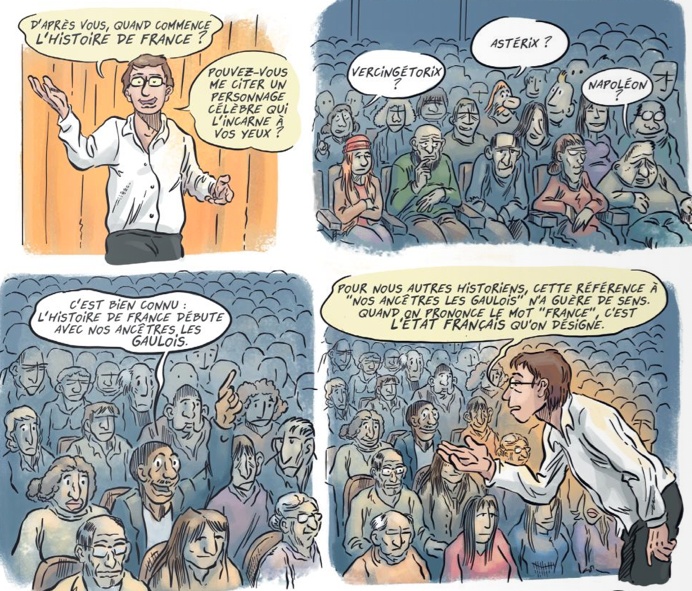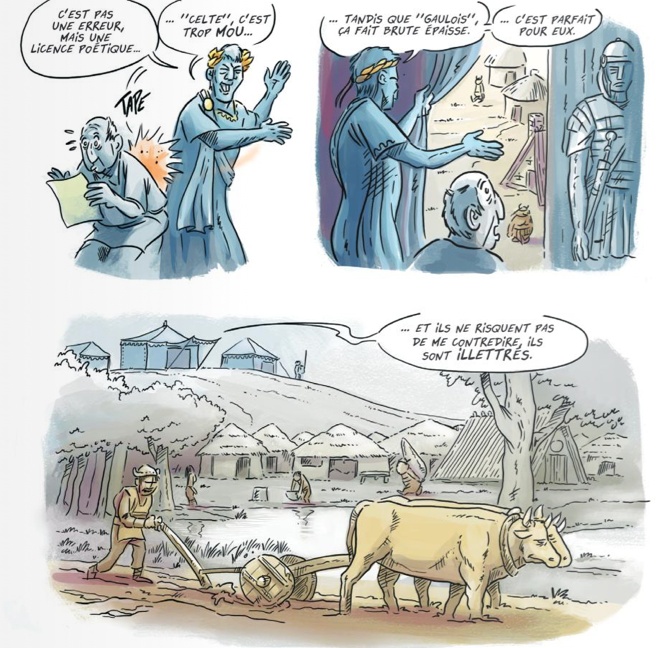Clovis, Louis XIV or Napoleon are historical figures known to all but what do you know about the Croquants, Pierre de Conninck or the Communards? To answer this, the first volume of Une histoire populaire de la France invites you to discover in comics another vision of France.
Other events
 In Une histoire populaire de la France, the historian Gérard Noiriel left the imposed figures of the past to speak of the people. Following the success of this book, Delcourt Editions chose to adapt it into a comic book. As in the original text, we find the chronological plan and the choice to alternate known political figures – kings and queens – but also peasants and anonymous workers, men and women too long left out of the official narrative. Noiriel starts from the best-known stereotypes about Gallic ancestors and leads the reader by the hand for a literal dive into the history of France. He overthrows the idols of the national novel, this frozen vision of the past, to show the historical reality behind the representations. If the term "Gauls" is a creation of the Romans, the Celts did occupy the France but they never formed a pure people and they experienced many migrations. In A People's History of France, we understand that the past is not written by the victors but by the dominant. Gérard Noiriel demonstrates the perpetuation of exploitation, from the serfs of the Middle Ages to the workers of the industrial revolution. This era is a time of oppression of the people by the lords except during the anti-tax revolts. The reader observes the coordination of the privileged to impose their power on the masses. In the first chapters, there are few individuals except a few peasants who are fine talkers. The modern and contemporary era changed things with rebels like Pierre de Conninck and even thieves like Cartouche. The real revolution comes through religion – the Protestant currents – but the people are again betrayed by the elites because the political and religious elite refuse to share power.
In Une histoire populaire de la France, the historian Gérard Noiriel left the imposed figures of the past to speak of the people. Following the success of this book, Delcourt Editions chose to adapt it into a comic book. As in the original text, we find the chronological plan and the choice to alternate known political figures – kings and queens – but also peasants and anonymous workers, men and women too long left out of the official narrative. Noiriel starts from the best-known stereotypes about Gallic ancestors and leads the reader by the hand for a literal dive into the history of France. He overthrows the idols of the national novel, this frozen vision of the past, to show the historical reality behind the representations. If the term "Gauls" is a creation of the Romans, the Celts did occupy the France but they never formed a pure people and they experienced many migrations. In A People's History of France, we understand that the past is not written by the victors but by the dominant. Gérard Noiriel demonstrates the perpetuation of exploitation, from the serfs of the Middle Ages to the workers of the industrial revolution. This era is a time of oppression of the people by the lords except during the anti-tax revolts. The reader observes the coordination of the privileged to impose their power on the masses. In the first chapters, there are few individuals except a few peasants who are fine talkers. The modern and contemporary era changed things with rebels like Pierre de Conninck and even thieves like Cartouche. The real revolution comes through religion – the Protestant currents – but the people are again betrayed by the elites because the political and religious elite refuse to share power.
Other characters
 Une histoire populaire de la France is a collective work with two screenwriters, Lisa Lugrin and Clément Xavier. They ask themselves the right questions: how to create a link on a history of more than two centuries? Everything starts from a gesticulated conference by Gérard Noiriel attended by a father passionate about history and his daughter. The teenager is, initially, the least motivated. Worse, she finds her old and bearded history teacher. But it is through the word of the historian that the story finds a link and through the adolescent that the reader identifies with this historical marathon. Over such a long period of time, the historian and the screenwriters make choices. Much of this first volume focuses on the Middle Ages. A popular history of France does not form a single continuity like Europe to America. We understand the formation of colonial exploitation and then we see the nation and the people speak out, with or without intermediaries, until the French Revolution. This complex period becomes crystal clear. We see progress in all areas, including unfortunately military techniques during the Thirty Years' War. Lisa Lugrin and Clément Xavier show the place and actions of women at different times. But a popular history of France is not a leaden book. Elements have a very current resonance. Colbert manipulates the identity – of the nobility – to strengthen power. Like an advertisement, the image of the king is broadcast on all media to strengthen his aura. The reading is quite dense but concrete examples make it possible to capture the important moments – such as the birth of villages – and the drawings help a lot to lighten the reading. The writers add humor and the cartoonist Alain Gaston Rémy adds with this politician who receives a bust of Justinian to prevent him from talking nonsense. The drawing accurately transcribes the facts. The narrative is always readable by the use of large boxes without edges. The reader will be able to recognize, repeatedly, medieval images and well-known paintings. A popular history of France offers a committed vision of the past. It is rich in precise information. Even the history teacher in the audience learns a lot thanks to Gérard Noiriel. The people always reject the yoke when it becomes too heavy or visible. The volume closes with a promising announcement of the second part, the story after the Commune. If you are passionate about historical stories, you can find chronicles on Doctor Radar and September 11 in the comics.
Une histoire populaire de la France is a collective work with two screenwriters, Lisa Lugrin and Clément Xavier. They ask themselves the right questions: how to create a link on a history of more than two centuries? Everything starts from a gesticulated conference by Gérard Noiriel attended by a father passionate about history and his daughter. The teenager is, initially, the least motivated. Worse, she finds her old and bearded history teacher. But it is through the word of the historian that the story finds a link and through the adolescent that the reader identifies with this historical marathon. Over such a long period of time, the historian and the screenwriters make choices. Much of this first volume focuses on the Middle Ages. A popular history of France does not form a single continuity like Europe to America. We understand the formation of colonial exploitation and then we see the nation and the people speak out, with or without intermediaries, until the French Revolution. This complex period becomes crystal clear. We see progress in all areas, including unfortunately military techniques during the Thirty Years' War. Lisa Lugrin and Clément Xavier show the place and actions of women at different times. But a popular history of France is not a leaden book. Elements have a very current resonance. Colbert manipulates the identity – of the nobility – to strengthen power. Like an advertisement, the image of the king is broadcast on all media to strengthen his aura. The reading is quite dense but concrete examples make it possible to capture the important moments – such as the birth of villages – and the drawings help a lot to lighten the reading. The writers add humor and the cartoonist Alain Gaston Rémy adds with this politician who receives a bust of Justinian to prevent him from talking nonsense. The drawing accurately transcribes the facts. The narrative is always readable by the use of large boxes without edges. The reader will be able to recognize, repeatedly, medieval images and well-known paintings. A popular history of France offers a committed vision of the past. It is rich in precise information. Even the history teacher in the audience learns a lot thanks to Gérard Noiriel. The people always reject the yoke when it becomes too heavy or visible. The volume closes with a promising announcement of the second part, the story after the Commune. If you are passionate about historical stories, you can find chronicles on Doctor Radar and September 11 in the comics.


















